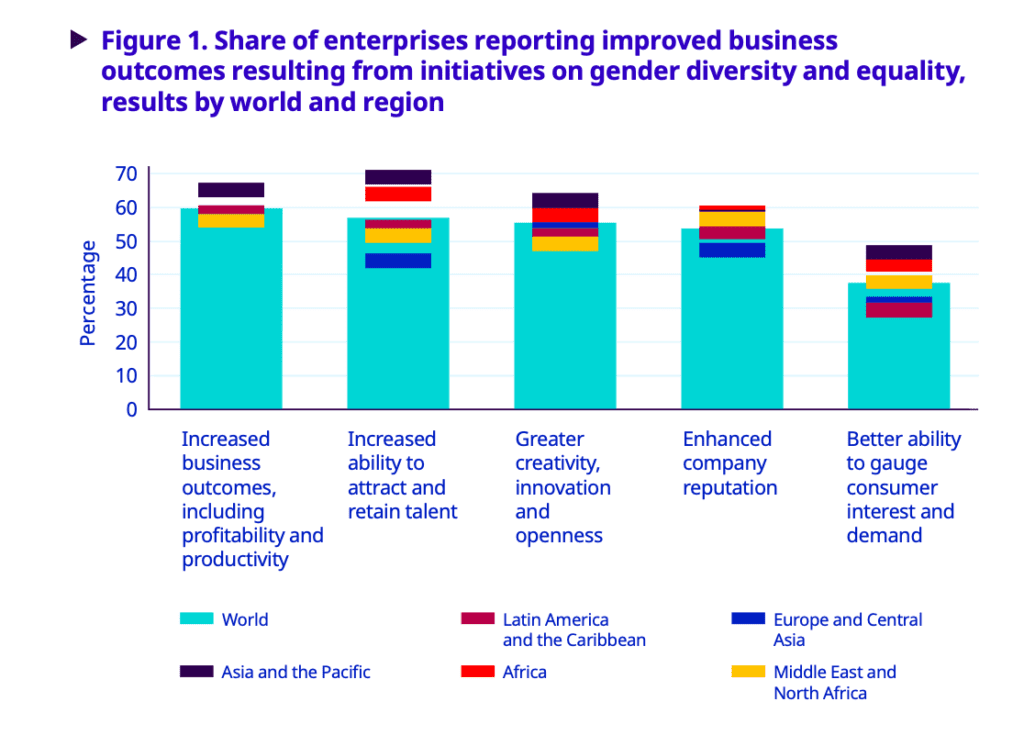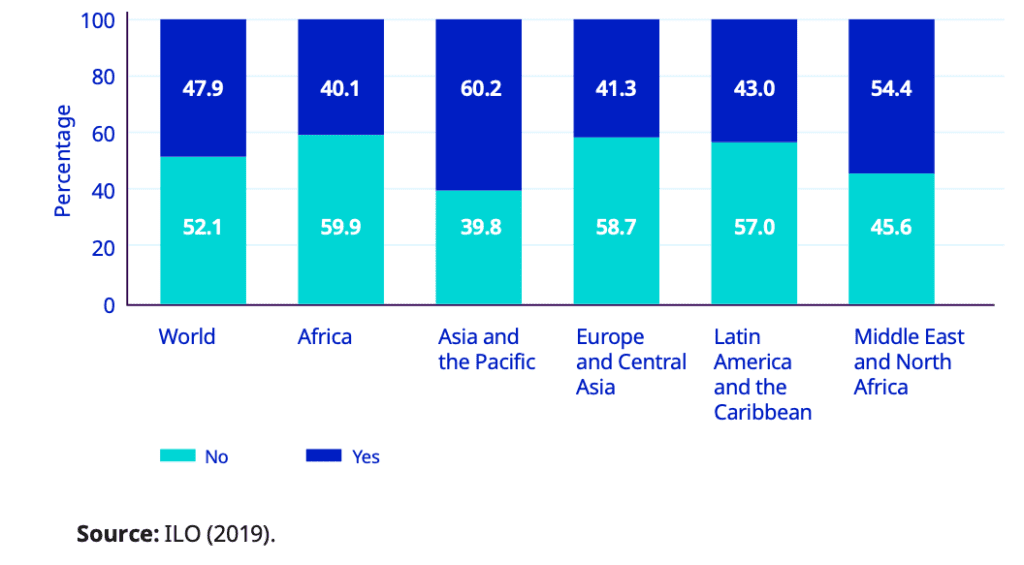There is mounting evidence around the globe that promoting gender diversity among employees, management and boards can be a business boost and a boost to economies. This article examines the business case for gender diversity by exploring how enterprises are integrating women’s representation in the workplace, particularly in management and boardrooms, as a key component of their business strategy.
The global enterprise survey on Women in Business and Management, con- ducted together with employer and business membership organizations (EBMOs), included nearly 13,000 surveyed enterprises in 70 countries across five regions (Africa, Asia, and the Pacific, Europe and Central Asia, Latin America and the Caribbean, and the Middle East and North Africa). The findings of the survey are mentioned in the report titled “The Future of Diversity”. It was published by International Labour Organisation in December 2021.
The business case for gender diversity
The most salient finding of the survey is that gender diversity is a smart business strategy: lack of gender diversity could impede enhanced business performance. Most enterprises, in all size categories, reported that gender diversity helps improve business outcomes (see figure 1).
 Source: ILO
Source: ILO
Of the enterprises surveyed that tracked the quantitative impact of gender-diversity initiatives on promoting women in management, nearly 74 percent reported a profit increase of between 5 and 20 percent.
The assessment further shows that enterprises with a gender-inclusive culture are 9 percent more likely to have improved business performance. These are significant numbers, considering the measures companies take to squeeze out 2–3 percent increases in margins.
Research has shown that when top executive positions and boards are gender diverse, there are more women in middle and senior management positions (avoiding the leaky pipeline), less occupational gender segregation (helping to eliminate the glass walls), and a more inclusive workplace environment overall.
The obstacles: From the classroom to the boardroom, and beyond
Globally, of those completing tertiary education the majority (53.3 per cent) are women. However, in highly demanded fields of study, including science, technology, engineering and mathematics (STEM) disciplines, men continue to dominate.
Figure 2. Share of enterprises according to whether retention of skilled women is a challenge for their organization, results by world and region

Women in chief executive positions
While the share of women decreases in the rise in hierarchy from general employment, to lower and middle management, then further to senior and executive management positions, the drop in the share of women in the posi- tion of CEO is even more significant. Reportedly, only 22 per cent of all CEO positions globally are occupied by women (see figure 4).
The share of enterprises headed by a woman CEO was found to decrease as the size of enterprises increases: 26 per cent of small enterprises have women CEOs, compared with 20 per cent of medium-sized enterprises and 16 per cent of large enterprises.
Figure 3. Gender of the CEO in enterprises results by world and region
 Globally, 76.4 per cent of survey respondents agree or strongly agree that their corporate culture mirrors the traditions and social norms of their society. Therefore, work on eliminating gender bias needs to begin in families, schools and society at large, in support of gender-inclusive corporate cultures that improve business outcomes and competitiveness.
Globally, 76.4 per cent of survey respondents agree or strongly agree that their corporate culture mirrors the traditions and social norms of their society. Therefore, work on eliminating gender bias needs to begin in families, schools and society at large, in support of gender-inclusive corporate cultures that improve business outcomes and competitiveness.
Survey findings globally indicate that over 73 per cent of enterprises have an equal opportunity policy or diversity and inclusion policy in place (see figure 6). Analysis of these findings show that enterprises with these policies help increase the share of women in management positions.
Getting on the board
In the same vein, when a board includes women board members, and particu- larly when a board is gender-balanced or chaired by a woman, there is a positive impact on the share of women in management. For example, when the board is gender-balanced, that is, demonstrates 40 to 60 per cent of either sex:
- X Enterprises are 3.1 per cent more likely to have women in senior management positions; and
- X Enterprises are 6 per cent more likely to have women in top executive positions.
Glass walls, leaky pipelines and glass ceilings
The leaky pipeline and glass ceilings limit the vertical advancement of women, and glass walls present another barrier on the way to the top. Glass walls restrict progression even when men and women are on the same hierar- chical level by segregating functions and placing women in less strategic and non-decision-making positions whereas men occupy roles that lead more directly to promotion to the highest positions
Figure 4. Share of enterprises with equal employment opportunity or diversity and inclusion policies results by world and region
 The business case for gender diversity is compelling, particularly in terms of increasing the proportion of women in management and on boards. The full support and accountability of managers at all levels are critical, especially for ensuring that top management is visible and vocal in advocating for gender diversity and inclusive business culture. From this, a virtuous circle can evolve. A more gender-balanced workforce can lead to more women CEOs and in turn, to more women on boards. More women on boards increase the appointment of more women CEOs, which leads to a more gender-balanced workforce and overall, a workplace that is more diverse, equitable, and inclusive.
The business case for gender diversity is compelling, particularly in terms of increasing the proportion of women in management and on boards. The full support and accountability of managers at all levels are critical, especially for ensuring that top management is visible and vocal in advocating for gender diversity and inclusive business culture. From this, a virtuous circle can evolve. A more gender-balanced workforce can lead to more women CEOs and in turn, to more women on boards. More women on boards increase the appointment of more women CEOs, which leads to a more gender-balanced workforce and overall, a workplace that is more diverse, equitable, and inclusive.
About the author: Vanita is a lawyer and Lead – Research & Communications at Ungender. She writes extensively on building inclusive workplaces, gender issues, social inequalities, and public policy.
Ungender Insights is the product of our learning from advisory work at Ungender. In our initiative to build inclusive workplaces for all individuals, we continue to educate and advise leaders on the same. Write to us at contact@ungender.in to know more about our advisory services.










